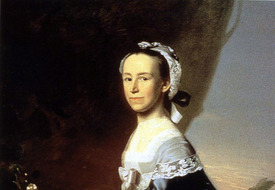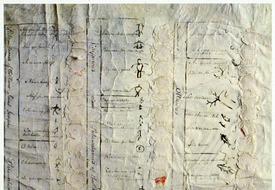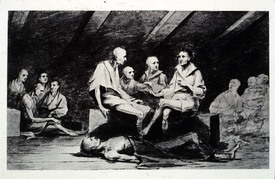Copley, Mercy Otis Warren, c. 1763
Image ID: 12454
Collection: Alan Taylor
Topic(s): Revolution, Arts and Architecture
Region(s): North America
CA Standard(s): 5.6 - The course and consequences of the American Revolution, 8.1 - Major events preceding the founding of the nation and the development of American constitutional democracy, 11.1 - The significant events in the founding of the nation and its attempts to realize the philosophy of government described in the Declaration of Independence
National Standard(s): Revolution and the New Nation (1754-1820s)
Card Text: John Singleton Copley, "Mercy Otis Warren," a prolific American author, historian, patriot, and revolutionary. Oil on canvas, c. 1763.
Citation: Copyright © Museum of Fine Arts, Avenue of the Arts, 465 Huntington Ave, Boston, MA 02115-5597. Bequest of Winslow Warren, 1931. Acc. No. 31.212. All rights reserved.
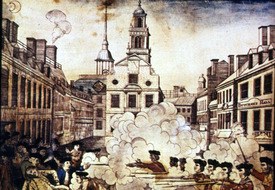
Revere, The Bloody Massacre, 1770
Image ID: 13087
Collection: Alan Taylor
Topic(s): Revolution
Region(s): United States
CA Standard(s): 5.6 - The course and consequences of the American Revolution, 5.6 - The course and consequences of the American Revolution, 5.5 - The causes of the American Revolution, 8.1 - Major events preceding the founding of the nation and the development of American constitutional democracy
National Standard(s): Revolution and the New Nation (1754-1820s)
Card Text: Paul Revere, "The Bloody Massacre" (the Boston Massacre), "perpetrated in King Street Boston on March 5th 1770 by a party of the 29th Regt.," 1770. British troops firing on a group of citizens on a street in Boston, Massachusetts, with the Royal Custom House known as "Butcher's Hall" on the right, and the First Church and Town House in the background. Some of the wounded are being carried away from the scene while others lie in the street. Engraving.
Citation: Library of Congress Prints and Photographs Division, Washington, DC 20540. LC-DIG-ppmsca-19159.
Treaty of Greenville, 1795
Image ID: 13097
Collection: Alan Taylor
Topic(s): Revolution, Native Americans
Region(s): United States
CA Standard(s): 5.6 - The course and consequences of the American Revolution, 8.4 - The aspirations and ideals of the people of the new nation, 8.1 - Major events preceding the founding of the nation and the development of American constitutional democracy
National Standard(s): Revolution and the New Nation (1754-1820s)
Card Text: Forced to sign away their rights to the Ohio Valley in the Treaty of Greenville, 1795, Native Americans made their marks beside the English spelling of their names.
Citation: US National Archives and Records Administration, 8601 Adelphi Rd, College Park, MD 20740-6001.
American POWs on British Prison Ship Jersey in New York Harbor, 1779-83
Image ID: 13143
Collection: Alan Taylor
Topic(s): Revolution
Region(s): United States, North America
CA Standard(s): 5.6 - The course and consequences of the American Revolution, 5.6 - The course and consequences of the American Revolution, 8.5 - U.S. foreign policy in the early Republic
National Standard(s): Revolution and the New Nation (1754-1820s)
Card Text: American prisoners of war starve to death on the British prison ship "Jersey" in New York Harbor, 1779-83. Purposely brutalized, between 11,000 and 13,000 died, 75% of the total imprisoned. King George III considered them traitors and as such without rights. More Americans died in British prison ships in New York Harbor than in all the battles of the Revolutionary War.
Citation: Fordham University Library, Charles Allen Munn Collection, Rose Hill Campus, Bronx, NY 10458.
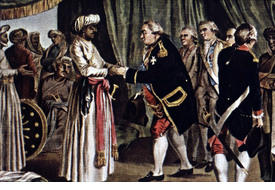
French Admiral Suffren Meeting Indian Ruler Hyder Ali, 1783
Image ID: 13161
Collection: Alan Taylor
Topic(s): Revolution
Region(s): Asia, Europe, North America
CA Standard(s): 5.6 - The course and consequences of the American Revolution, 5.3 - The cooperation and conflict among the American Indians and between the Indian nations and the new settlers, 8.1 - Major events preceding the founding of the nation and the development of American constitutional democracy
National Standard(s): Revolution and the New Nation (1754-1820s)
Card Text: J.B. Morret, "French Admiral Suffren meeting with the Indian ruler Hyder Ali," his ally and the leader of the Mysore revolt against British rule in India, 1783, in Cuddalore. Suffren engaged the British fleet in the last battles of the American Revolution, which were fought on the other side of the world - on the Indian and Ceylonese coasts. Engraving, 1789.
Citation: Original painting Copyright © Bibliothèque nationale de France, site François-Mitterrand, quai François-Mauriac, 75706 Paris Cedex 13, FRANCE. All rights reserved.
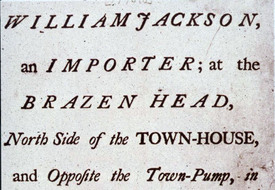
Broadside, Boycott of Merchant who Continued to Stock English Goods, Boston, 1770
Image ID: 7820
Collection: Karen Halttunen
Topic(s): Eighteenth Century, Revolution, American Revolution, British Empire, Business, Civil Rights, Class Structure, Colonial America, Decolonization, Domesticity, Early Ads, Imperialism, Individualism, Technology, Institutions and social disorder, Invention, Labor Organizations and Leaders, Luxury, Middle-Class Culture, National Events, Nativism, Politics & Government, Pre-Industrial Work - Misc., Propaganda, Stores, Strikes and Violence, Symbols, Taxes, Trade, Women in the Revolution, Women's image, Women's organizations, Work and Workers
Region(s): United States, North America
CA Standard(s): 8.1 - Major events preceding the founding of the nation and the development of American constitutional democracy, 5.4 - Political, religious, social, and economic institutions that evolved in the colonial era. , 5.5 - The causes of the American Revolution, 5.6 - The course and consequences of the American Revolution, 5.7 - People and events associated with the development of the U.S. Constitution and it's significance as the foundation of the American republic
National Standard(s): Revolution and the New Nation (1754-1820s)
Card Text: Broadside urging the American boycott of merchant William Jackson, who continued to stock English goods at his Boston business, MA, 1770. "It is desired that the Sons and Daughters of Liberty, would not buy any one thing of him, for in so doing they will bring disgrace upon themselves, and their Posterity, for ever and ever, AMEN." Like the Stamp Act of 1765, the Townshend Acts of 1767 produced controversy and protest in the American colonies. Many colonists again resented an effort to tax them without representation and thus to deprive them of their liberty. The revenue raised by the Townshend Acts would pay royal governors, taking away the right of colonial legislatures to set or withhold a royal governor’s salary. The Restraining Act, intended to isolate New York without angering the other colonies, had the opposite effect, showing how far beyond the British Constitution some members of Parliament were willing to go.
The Townshend Acts generated a number of protest writings, including “Letters from a Pennsylvania Farmer” by John Dickinson. This influential pamphlet circulated widely in the colonies, arguing that Parliament could not impose either internal taxes, like stamps on goods, or external taxes, like customs duties on imports.
Women were encouraged to boycott British goods, especially tea and linen, and to manufacture their own homespun cloth. Building on the Daughters of Liberty protest of the 1765 Stamp Act, the non-importation movement of 1767–68 mobilized women as political actors.
In 1768, Samuel Adams wrote "The Massachusetts Circular" to the other colonial legislatures, asserting the unconstitutionality of taxation without representation and encouraging protest through boycotting British goods. This letter's humble tone shows the Massachusetts Assembly’s continued deference to parliamentary authority. Even in that hotbed of political protest, it clearly expresses allegiance to Britain and the hope for a restoration of “natural and constitutional rights.”
Britain’s response to this threat of disobedience served only to unite the colonies further. Lord Hillsborough demanded that the Massachusetts colony retract the letter, and warned that any colonial assemblies that endorsed it would be dissolved. This ultimatum pushed the other colonies to Massachusetts’s side. Even the city of Philadelphia, which had originally opposed the Circular, came around. The Daughters of Liberty once again supported the boycott of British goods. Women resumed spinning bees and again found substitutes for British tea and other goods. Many colonial merchants signed non-importation agreements, and the Daughters of Liberty urged colonial women to buy only from those merchants. The Sons of Liberty used newspapers and circulars to call out by name those merchants who refused to sign such agreements, sometimes threatening violence. The 1768–69 boycott turned the purchase of consumer goods into a political act: A person's very clothes indicated whether they "defended liberty" in homespun or protected parliamentary rights in fine British attire.
Citation: Library of Congress Prints and Photographs Division, Washington, DC 20540. LC-USZ62-43568. Text: "The Townshend Acts," OpenStax. https://open stax.org/books/us-history/pages/5-3-the-townshend-acts-and-colonial-protest. © 1999-2019, Rice University, 6100 Main St, MS-375, Houston, TX 77005. All rights reserved. May 17, 2020.
Execution of King Louis XVI of France, Paris, 1793
Image ID: 12532
Collection: Alan Taylor
Topic(s): Canada, Revolution
Region(s): United States, Europe
CA Standard(s): 10.2 - Glorious Revolution of England, the American Revolution, and the French Revolution and their enduring effects worldwide on political expectations for self-government and individual liberty , 10.2 - Glorious Revolution of England, the American Revolution, and the French Revolution and their enduring effects worldwide on political expectations for self-government and individual liberty
National Standard(s): An Age of Revolutions, 1750-1914
Card Text: Execution of King Louis XVI of France on the guillotine, Paris, 1793. Unidentified artist; print.
Citation: Source unknown. Original at Bibliothèque nationale, site François Mitterrand, quai François-Mauriac, 75706 Paris Cedex 13 FRANCE.
